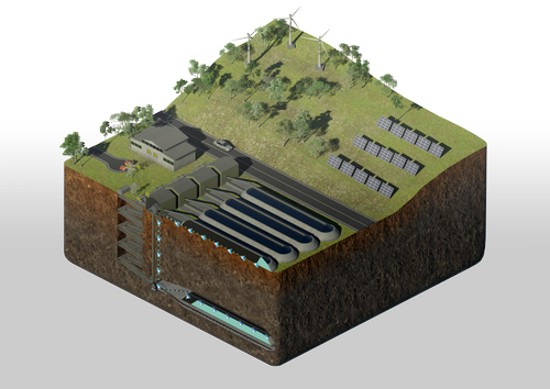Last week I interviewed an energy startup company from Adelaide, Australia. The company’s system is called VIPER an acronym for Vertical Integrated Potential Energy Reservoir. In other words, it’s a battery but without an anode or cathode. Instead, it generates its energy by shifting masses of pellets from a height and using a vertical drop of as much as 1,000 metres, converting the kinetic energy produced into electricity. It can generate 60 Megawatts over a 10-hour period. The company’s name is Economical Energy and although it is still in the early stages of getting a pilot project underway, the upside to putting hundreds of VIPER facilities in play in the next 30 years can help the planet get closer to net zero by 2050.
An MIT Technology Review article published today and written by Casey Crownhart calls this thinking “outside the battery.” The concept is simple and as I have previously noted there may be many potential sites to put novel storage technologies in play to support intermittent renewable energy from wind and solar.
The challenge for companies like Economical Energy is to get investors to stop thinking about energy production as restricted to burning fossil fuels, capturing energy from the wind and sun, from the power of falling water, or from chemical-based battery packs such as those being built by Tesla.
A battery can be completely reimagined. What you need is to create kinetic energy to drive turbines attached to generators. I call these novel technologies kinetic batteries.
Here are four different types of kinetic batteries:
- Pumped storage is a technology that has been around for more than a century. It involves creating a way to use the latent energy in moving water and turning it into electricity. Water is moved uphill to a reservoir where it is stored. When power is needed it is released to flow downhill and generate electricity. You most often find pumped storage projects attached to hydroelectric facilities and dam sites.
- Compressed-air storage turns pressure into electricity. It involves pushing and compressing ambient air into a sealed cavity. The cavity can be an abandoned oil or natural gas field underground or even an above-ground building. When peak energy demand requires it, the compressed air can be released, and voila, you have electricity. The state of California recently entered into a business arrangement with Hydrostor, a company that describes itself as the world’s leading developer of Advanced Compressed Air Energy Storage (ACAES). California will store compressed air in natural geological formations underground. It is expected to have this project operational by 2028.
- Gravity-energy storage is what Economical Energy and some other companies have proposed. These include Gravitricity, a Scottish company that is building a working gravity-mass demonstrator at a former deep mine in Czechia (Czech Republic), and Energy Vault, from Switzerland with a technology that uses mechanical processes to lift and lower composite blocks which can store and generate electricity.
- Geothermal well storage involves pumping water into the ground where geothermal energy plants exist. The extra water when pumped underground increases pressure which when released produces power well in excess of conventional geothermal facilities. Fervo Energy describes itself as a next-generation geothermal energy producer. Fervo’s enhanced geothermal may become the model for geothermal energy systems in the future bringing the technology into the mainstream. The company is building a 5-megawatt powerplant for Google in Nevada.
All of these kinetic battery solutions can provide a steady flow of power to an evolving grid where much of the energy will come from intermittent renewables like wind and solar. The kinetic batteries described above are a solution to the intermittency problem providing the power needed to fill in those waning periods when renewables cannot generate enough to meet demand.









[…] Vault has been designing and building GESS projects for some time. It is one of several companies focused on delivering to the market kinetic energy gravity-based solutions. Recently the company completed its first commercial G-Vault project in Rudong, China, a standalone […]